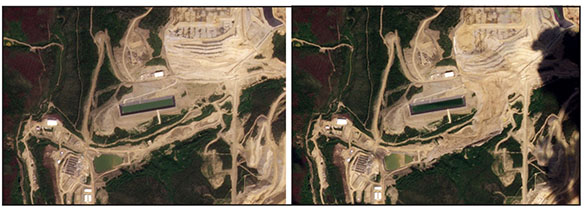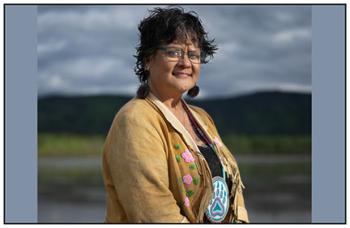Image Caption
Local Journalism Initiative Reporter
Windspeaker.com
The First Nation of Na-Cho Nyäk Dun is demanding an independent investigation into the June 24 leach pad failure at Victoria Gold Corp.’s Eagle Gold Mine, 85 kilometres north of the First Nation in Mayo, Yukon.
There is a serious risk of cyanide contamination, said Chief Dawna Hope, and more than one nation is downstream.
Hope is the first female chief of Na-Cho Nyäk Dun and holds a degree in Northern Environmental and Conservation Sciences from Yukon University and the University of Alberta.
She said the failure occurred on the mine’s leach pad itself, causing a landslide.
“The severity of contamination from cyanide, as well as other chemicals, has not been publicly conveyed. This event has implications on all life in the region, including salmon stock recovery,” said Hope.
“The Elders have always been concerned about the project because it was literally taking down a mountain and filling up a valley,” she said.
The containment failure has buried the valley named Dublin Gulch and could contaminate groundwater, reads the nation’s press statement about the incident.
Na-Cho Nyäk Dun demands an immediate pause to all mining operations in its territory. For its part, Victoria Gold Corp has temporarily suspended operations “while the site operations team along with management continue to assess the situation and gather information” reads the company’s June 24 acknowledgement of the event.
“At this early stage, it can be confirmed that there has been some damage to infrastructure and a portion of the failure has left containment. There have been no injuries to personnel associated with the incident,” the statement reads.
But Chief Hope calls for more than internal assessment. She is calling for independent investigation of the scale and scope of the failure.
“What is currently in place is insufficient and it's not being monitored or enforced, and we believe it contributed to this event.”
“We would like to see a pause on mining activity to ensure that all the necessary checks and balances are in place to protect lands, waters, wildlife and people into the future,” said Hope.
Leach pads are often lined on bottom and sides with plastic to protect soil and the environment from chemicals. In this case, explained Hope, an entire valley was used, to be “filled with the heap leach and ore.”
She said a chemical solution is poured on top, passing through the heap to the bottom. At the Eagle gold mine, “they recover the solution at the bottom and re-pump it up to the top, so that they can reuse that solution,” the chief said.
“This failure has taken out that facility to be able to take that solution out of the bottom and recycle it through the top.”
Dave Petley is a global expert in researching and managing landslides. He estimates the landslide to be “1,430 metres from crown to toe (along the landslide track)” and up to 370 metres wide. Planet Lab shared before and after satellite photos with Windspeaker.com to show the scope of the slide.

Judging from the photos, Hope said, “two thirds of it is outside of containment.”
The Na-Cho Nyäk Dun emphasized the need for an independent investigation to assess the environmental and health impacts of the event.
Hope notes the mining company’s water tests won’t show groundwater contamination immediately.
“I don't really think that we're going to have a true story with the initial results. I think that the story is going to unfold because this is a heap leach. It is that leaching process. That's not a quick thing.”
“It will take time. If it gets into the groundwater, which we believe it is, it could slow that process down and it could contaminate the groundwater system for who knows how long."
The heap leach pad failure and potential resulting cyanide contamination “is the most recent of many examples of how lack of mining regulation and negligent government oversight is threatening community and wildlife health and safety,” reads the nation’s statement.
“Mining brings benefits to the region, but it requires a precautionary approach and rigorous oversight. Nearly half of all the Yukon’s mining activity (more than 80,000 claims) is within the (Na-Cho Nyäk Dun) territory,” the statement continues. “Very few projects (less than one per cent) are denied and there is little oversight or enforcement of operations. The status quo is not tenable.”
“We have been sounding the alarm for decades on the need for sustainable development and responsible mining,” said Hope. “The integrity of our lands, people and ecosystems are our top priority.”
Dublin Gulch runs into waterways, including salmon spawning rivers, Hope said.
“Dublin Gulch runs into Haggart Creek, and Dublin Gulch is now buried. Haggart Creek runs into the South McQuesten where we have our spring fishery.”
Hope expressed concern for neighbouring First Nations downstream, and “made them aware of the situation and have requested that they also ramp up their water monitoring during this period.”
“The best-case scenario and my ultimate hope is we're wrong. I truly hope we're wrong, and it did not get to the groundwater,” said Hope.
“We're definitely prepared to take action both on the ground and whatever else we have to do once we get the results to the extent of the damage,” Hope said.
The situation is compounded with nearby wildfires. The nation is under evacuation alert and has proactively evacuated Elders to Whitehorse.
As of Tuesday July 2, Yukon has 78 active fires and 14 full responses. All but two of these full-response fires are burning in the Dawson and Mayo fire districts.
Windspeaker has reached out to Victoria Gold Corp. for more information. They have yet to respond.
Local Journalism Initiative Reporters are supported by a financial contribution made by the Government of Canada.

